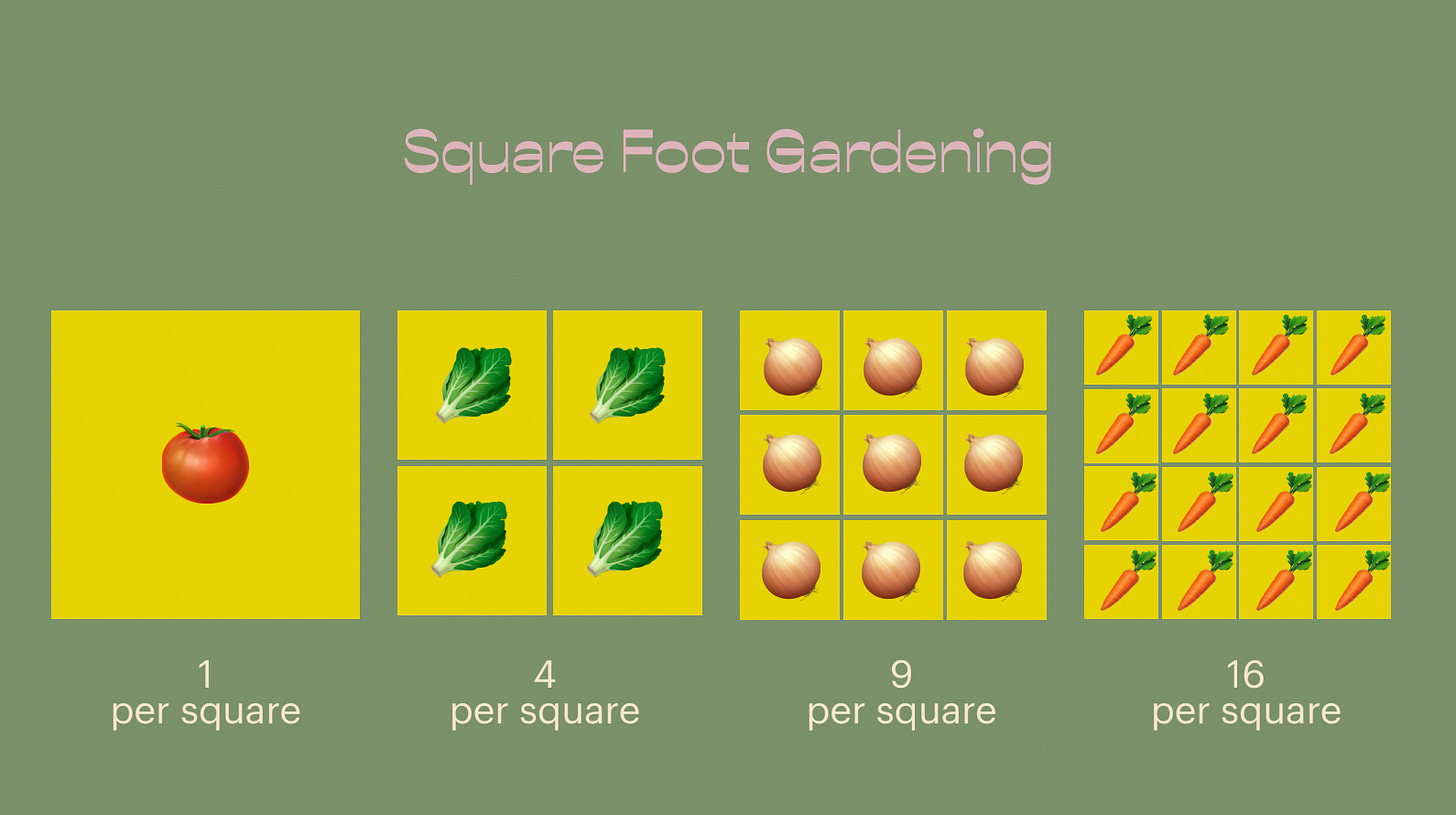📐 square foot gardening 📏
for gardening with kids, and with ourselves - plus, a strawberry ricotta crepe recipe
[already a SFG master? check out some writings from the archive - learn about the glorious bean, cool vs warm vs cold season crops, my favorite flowers for your veggie garden, or peruse lovely photos of the spring garden]
When I was 9 or 10 years old I must have found this book at the library, and I became obsessed with it. I loved the squares, the math, how everything added up. It felt so concrete and like a real “plan” I could follow.
If you have attended one of my classes or been a reader for a long time, you’ve probably gotten a quick overview of square foot gardening or “SFG” - but I thought I would dedicate a whole newsletter this week to it in honor of parents and children everywhere who want a little map to follow when spending time together in the garden.
WHY WAS THIS METHOD SO REVOLUTIONARY?
In 1981, a guy named Mel Bartholomew wrote a book called Square Foot Gardening which became the best selling garden book of all time. He was a civil engineer who grew up in California and was raised by a mother who loved gardening. After he retired and started volunteering at his community garden, he realized that growing in rows was not efficient or a great use of space.
Weeding and watering were taking way too long, and after a career focused on designing efficient solutions, his backyard became his next project.
Mel ended up on PBS and Discovery Channel, and most of us probably heard about his program at one point in our lives. We don’t have many horticultural “celebrities” in America but Mel was one. He arguably is why we have raised beds today in the form and prevalence that we do.
The SFG method arrived just as the “large row garden” was becoming inaccessible for so many Americans. Yards were getting smaller, people were moving into urban areas, our time was compressed, and we were looking for ways to use less water and be more responsible with resources.
Mel proved that growing in squares — rather than in rows — would cost half as much money, eliminate 80% of the weeds, and only take 10% of the water.
He found that 80% of a traditional row gardening was wasted space, and spent the rest of his life bringing gardens, food, and education to people struggling with hunger until he died at 85.
HOW DOES IT WORK?
It. Is. So. Simple. Rather than designing your garden in rows, create beds of any size and break them into a grid of 1x1 foot squares. [Mel always recommended 4x4’ beds, but you can make them any size that fits your area.]
You will dedicate each square foot to a type of plant. Instead of following the spacing on your seed packet, follow the SFG recommendation for that vegetable, fruit or herb. Here is an example chart:
Even if you don’t have a chart handy, you can make a pretty good guess: A tomato that needs 12” of space would mean 1 tomato plant per square. An onion that needs 4 inches of space would mean 9 onions per square (3 little rows of 3, inside the square).
Mel got famous for saying you only needed one 4x4’ bed per person in your home to grow all the produce you needed, so long as you transitioned from cool to warm, then back to cool season crops throughout the year. If you don’t know how big your garden should be, this is a great place to start.
A FEW TIPS ON THIS METHOD, FROM ME :)
SFG is a helpful principle to use in your garden, not something you must follow diligently. I garden intuitively, and I even have a few wide rows, but this has shown me how to place things closely together (which plants LOVE) and get more out of limited space. I think in terms of boxes now, and I can make decisions quickly.
Sometimes SFG calls for a LOT of something in a square foot. Trust your instinct. Either follow the rules, and then thin out — or trust yourself and plant a little less. You’ll learn what works for your garden over time.
SFG spacing is based on growing vertically, so for tomatoes, cucumbers, peas, etc, you will definitely need to trellis or cage in order to fit into such small spaces.
I have created my own SFG code in my free Master Planting Calendar based on what I’ve learned over the years; feel free to use it!
DESIGN RECOMMENDATIONS
Beds: The human arm can reach about 1.5-2 feet, so I recommend keeping bed at 4’ or less. You can make it as long as you want, but 4’ should be one of your dimensions. If gardening with kids, a 2 or 3 foot wide bed helps with their reach. 3’ allows for reach from a wheelchair on either side. If your bed is up against a wall or fence, strongly consider making very narrow 2 foot beds.
Paths/Walkways: I have primary and secondary pathways on my property. Primary paths are the “main routes” that I need to push wheelbarrows down and these are 3’ wide. Secondary paths are just walkways, and these are 2’. I typically have plants overhanging from beds, so the 2 and 3’ widths still feel narrow and cozy to me.
Container gardening: SFG works for pots, too! Treat a 12’ pot like a square foot, a 24’ pot like 2 square feet, etc.
HOW CAN I LEARN MORE?
There isn’t much more to the method, but the book is a good + simple read, and is well-worth purchasing for a child in your life, a new gardener, or to keep handy as a simple gardening manual.
You can also find their charts and other calendar cheatsheets on their Foundation website - or you can go on to pay to become a certified teacher.
A FUN SQUARE FOOT GARDENING TOOL
You don’t need any tools but this lil seeding square guy is so fun and fancy, that now I want it. It makes it fast and easy to plant 1, 4, 6, 9, or 16 of anything in a square foot.
STRAWBERRY RICOTTA CREPES
I am three years deep into strawberries and this year I have what feels like a luxurious amount of them. For the last 4 mornings, I have walked out my back steps and picked a handful of strawberries, and come back indoors to make strawberry ricotta crepes.
Crepes sound fancy but they’re just a thinner, eggier pancake - and I think they are superior to both pancakes and omelets. They are just as easy to make and the recipes requiring food processors, chilling time, or other high maintenance tasks I have found to be really unnecessary.
This is the recipe that I use and I love it. This makes about 8 crepes (enough for 2-3 people) and I split it in half and have 3 for myself.
// CREPES //
2 eggs3/4 cup milk1/2 cup water1 cup flour4 tablespoons melted butter1/2 tsp vanilla [optional]
Mix everything well in a small bowl (this is not a worry-about-over-mixing-situation) and pour into a hot, buttered skillet. It should sizzle immediately and be very thin. Flip after a minute or two and then remove from heat. Fill it with whatever you have handy and brings you joy. You really can’t go wrong.
In the fall, I love any sort of pumpkin + whipped cream + nutmeg + cinnamon filling, and in the summer I just slice up whatever berries I have, sprinkle them with sugar, and set them aside while I make the crepes.
For strawberry + ricotta, I drop a tablespoon of ricotta into each crepe with a hefty pile of strawberries - and then sprinkle on top with a generous amount of powdered sugar.
PS. Like all pancake / crepe situations, the first one might be the lamest - so if you don’t like it at first, keep going.
Alright my friends - thank you for reading this week’s newsletter. If there’s something you’d like to learn about in the next newsletter, leave a comment. If you have good advice for gardening with the SFG, leave a comment.
Lauren















Love this! I got into gardening via SFG, because (as you said) it felt so accessible and like a plan I could actually follow. Your strawberries look amazing! Ours are pretty lackluster this year - I'd love more insight on growing berries if that's no already somewhere back in the archives...
I loved this Lauren! I bought a book a while back called The Instant Box Garden, by Susan Patterson. Same concept. I have yet to build a box, but feel inspired by your newsletter. Any suggestions for limited sunlight?